Richard Branscombe
Welcome to Richard Branscombe's gallery. Richard is displaying a number of items which illustrate a whole range of techniques:| Here are some examples of Richard's work... |
|
| Many Club Members will have, no doubt, made
an earring stand like this one. This one is made of London Plane and will accommodate 14 pairs of earrings. |
 |
 | This is a 3-tiered version of a jewellery stand, which measures 100 mm dia by 300 mm tall.
It will accommodate 42 pairs of earrings. |
| This arrangement of five separate jewellery stands was made at the request of an avid earring collector and will accommodate
72 pairs of earrings. Made from an African hardwood the base is 200 mm dia and the tallest stand is 450 mm high. |
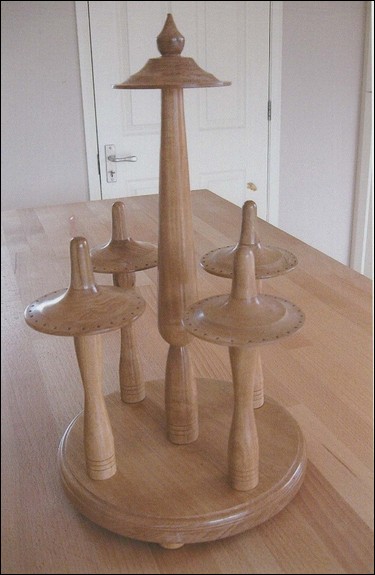 |
This lidded 'Saturn Bowl' with a finial was made for a Club competition. The timbers used is an African hardwood and ebony for the finial. The bowl is 250 mm dia with an overall height of 180 mm. The centre sphere is 125 mm dia. |
|
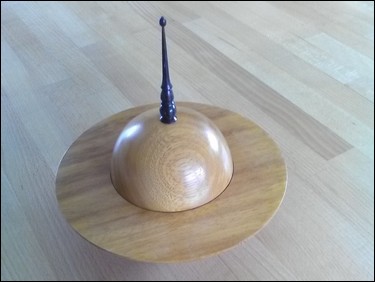 |
 |
| A Knitting Bowl, 175 mm dia by 200 mm tall - made from a piece of cherry. The shading is part of the outer bark and gives it a bit of colour. |
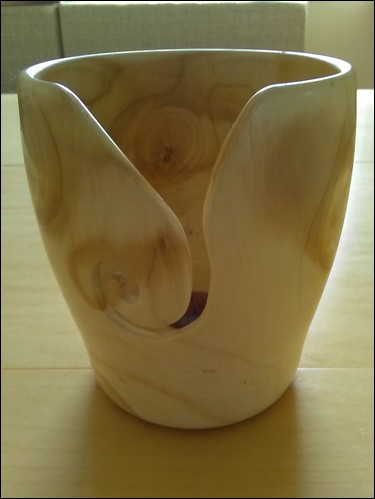 |
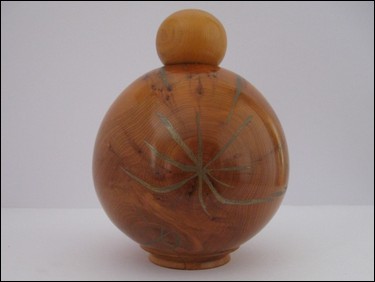 | This Spherical Vase is 150 mm dia and is made from the heart of a Yew tree. When the timber was drying, several splits have occurred.
Just prior to the finishing cut the shakes were infilled with aluminium powder and super glue.
The sphere has been hollowed out and then fitted with a smaller diameter threaded stopper. |
| The blank for this hollow vase was made from a hardwood blank - sandwiched between multiple layers of 1" birch ply -
this was then rotated on a 45 degrees axis and the hollow form shaped as shown. |
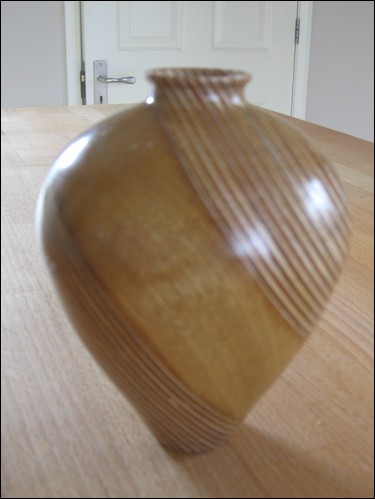 |
 | Made from Corian kitchen samples this
Pestle and Mortar measures 50 mm high by 50 mm dia. Being synthetic, Corian is quite messy to turn
and the highly polished finish is achieved by using a whole series of sanding grits starting with 180g and finishing with 2500g wet and dry abrasive. |
Many years ago I decided that I would make my eldest Granddaughter a Rocking Horse for her first birthday. The horse is made from plans supplied by The Yorkshire Rocking Horse Co. and is classified as a small horse measuring 4ft long by 4ft high. It is made up of sections of 1" and 2" elm planks. The only turning involved were the 2 vertical supporting pillars but the rest was hand carved and finished with several coats of varnish before all the leatherwork, mane and tail were fitted. The head of the Rocking Horse was carved as a separate entity and then attached to the body. All told it took me about 100 hours to complete. |
|
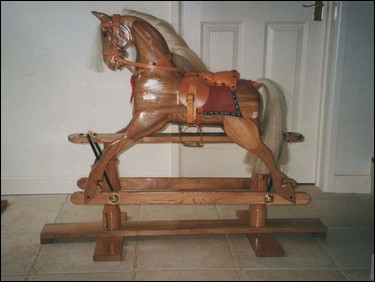 |
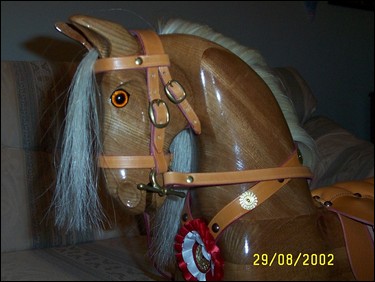 |
Richard has been exploring off-centre turnings. The first project is a Weather Station - utilising a home-made faceplate. Additional blocks of wood are added to the faceplate to act as counter balances - the turning speed is approx. 500 rpm. |
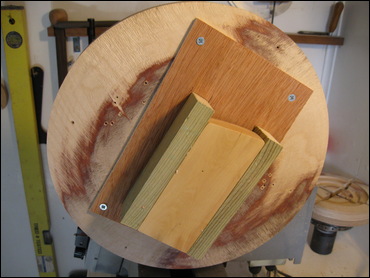 |
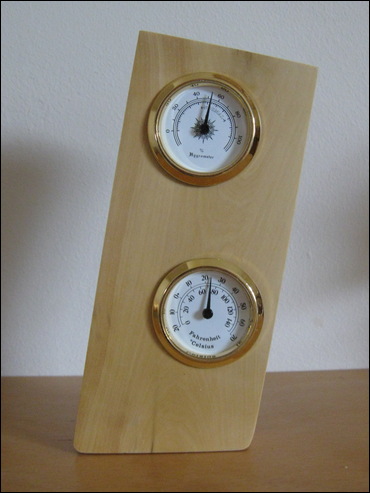 |
Richard's next project was to create a Peanut Bowl - which involves both split and off-centre turning. He has created a step-by-step set of photos to show how it was made. |
|
| Two blocks of wood (Walnut) approx 150 x 100 x 50 glued together using a paper joint and mounted on the lathe to turn a spigot to - be held in the chuck |
 |
| The workpiece mounted in the chuck and a 80mm dia hemisphere turned on the end using a 1/4" bowl gouge and a 3/8" parting/ beading tool to achieve the sharp corner. A template was used to check the curvature. |
      |
 The turned block is separated at the paper joint and hot-melt glued on to a temporary backing sheet of plywood along with a counter-balance piece of wood The turned block is separated at the paper joint and hot-melt glued on to a temporary backing sheet of plywood along with a counter-balance piece of wood |
 |
| The workpiece is lined up the centre point of the bowl using the rotating tailstock - before attaching the temporary backing plate on to a larger plywood face plate - mounted on the headstock |
 |
| A very shallow test cut was made to ensure the positioning is correct |
 |
| The bowl with a 70mm diameter hemi-spherical recess after it has been turned, sanded, sealed and finished. The completed bowl was removed from the faceplate - the initial spigot was cut off and then all faces were sanded, sealed and polished. |
 |
| Final result - side view |
 |
| Final result - view from above |
 |
Richard says "There are many times when you put a piece of wood in the lathe and not be sure what the outcome will be, this was one of those occasions. The piece of wood was 50 mm square by 400 mm long and was turned between 4 different centres - 2 balanced and 2 - unbalanced. The 'tongue' is a thin strip of lather and the 'eyes' were an exercise in miniature turning. This was the first and probably the last time I will do this, but if anyone else wants to have a go I can send them the instructions from "Multi-Centre Woodturning" by Ray Hopper" (there are two copies of this available in the Club Library) |
|
 |
 |
 |
It's true to say that at the beginning of their turning experience nearly everyone will have an attempt at turning mushrooms. Here is a group of three made from Laburnum. The tallest is 7" high x 3" dia and the mushrooms are brought out every Christmas as part of the decorations. |
| This fruit bowl measuring 11" dia x 4" deep is made from London Plane and was a commission. London Plane, also known as Lacewood, is a fairly soft wood which is very easy to turn and polish. | 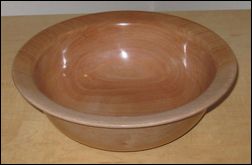 |
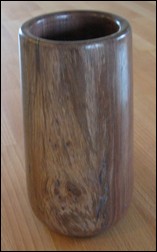 |
This is a Flower Vase made from American Black Walnut which I picked up on a trip to the USA in 1999 from Rhodes Batson - one of the original members who inaugurated the Association of American Woodturners. To make it suitable for holding flowers it has a standard straight sided 7" tall drinking glass (4 for £1.00 at Sainsbury's) inserted with a very loose fit inside it. |
| This is really a little bit of fun. I saw this as a plain little clock at a Craft Fayre many years ago which didn't have the 2 added mushrooms, which I think gives it a little more character. The clock dial is 63 mm and fits inside a 100 mm surround and is made from 1" thick elm offcuts and the mushrooms are of Box and Beech. |
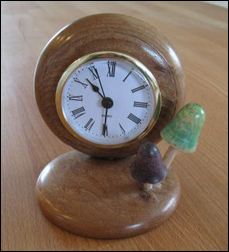 |
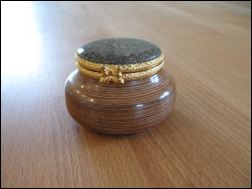 |
This was for a Clubnight Show and Tell with a brief of something made from 'wood and a manmade material'. The body of the lidded box, about 60 mm dia, is made from highly compressed beech ply which was used in WWII to build Mosquito aircraft. The lid insert is made from 5 mm thick Corian salvaged from an offcut of a kitchen worktop. |
| Another item that most woodturners have a go at is this elm burr Pot Pourri, only 7" dia and made from a piece left over from a wooden Rocking Horse. I am quite pleased with this as it was one of the earlier pots I made using a home-made tool to do the undercutting. |
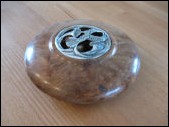 |
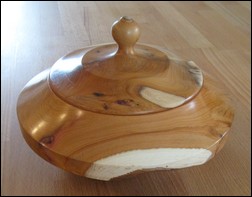 |
Another item from the Club competition for something made from Yew. This lidded pot is about 10" dia and as well as leaving part of the outside with a natural finish involved re-chucking both the base and lid to achieve the finished product. It was also necessary to use a jam chuck to turn the underside of the top. |
| I would not describe myself as an innovative woodturner and rely heavily on copying other peoples work. I saw an article in the Woodturning magazine describing how to make a candlestick with a ball candle. As candlesticks are always made in pairs I decided to make an asymmetric pair and this is the result. The wood is oak and they are made in 3 parts to save on material and also enjoy the benefit of the cross grain on the top and base. The larger of the candlesticks is 280 mm high by 110 mm diameter. |
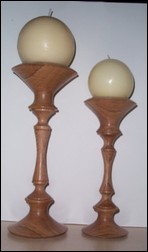 |
 |
I had some small offcuts of elm planking and decided to make good use of them to make a small arm chair for my granddaughter. It is scaled down from a full sized chair made by the famous Jack Hill and stands about 20" high. The seat was scalloped out using a combination of gouges and a 5" flexible Sanding Drum. |
| I was given the opportunity of turning something from a piece of oak that came out of St Andrews Church tower, in Shrivenham, when they rehung the bells last year. This oak is over a hundred years old and therefore very dry and tough to turn. The first piece I turned was this lidded goblet which was also awarded the Club Show and Tell trophy. Although not clear - the lid and finial are hand carved, having seen a carving demonstration given by Bristol woodturner Mary Ashton. | 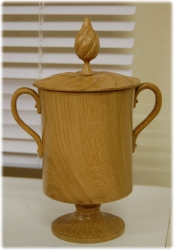 |
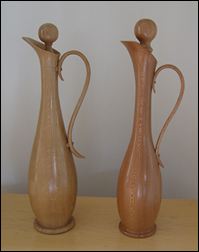 |
These are a pair 16" high hollow Jugs with the one on the left made from Shrivenham Church oak and the other from London Plane. Due to their length they needed the support of a homemade lathe steady to turn out the inside and I managed to achieve a wall thickness of around 5 mm. The oak one has a couple of little straps to attach the handle to the body because the first attempt to fix it went awry. You may notice that the very top shape is different with the oak one giving a narrow pouring lip whereas the London plane one has a very wide pouring lip. |
| The Fruit Bowl and Fruits are something I had promised my wife that I would make for her when I first started turning many years ago - and in 2012 it actually happened! The Fruit Bowl, 250 mm dia, is made from cherry, appropriately, and is different from the normal turned bowl in that it is only 30 mm deep on the inside,so that you can see all of the fruit in the bowl. The individual fruits are made from various woods including beech, oak, grass root etc. and stained where necessary. The banana was 'turned' using a 5" Flexible Sanding Drum. | 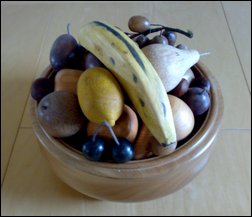 |
 |
Perhaps the most ambitious project I have done is this Mantlepiece Clock designed by Gary Rance, which he described in the Woodturning magazine a few years back. It involves several disciplines of woodturning including spindle turning, facepate work, making exact replicas of the supporting columns, re-chucking and jam chucks as well as drilling jigs. It stretched me as a turner and gave me the confidence to try other things. The clock has an overall height of 290 mm by 190 mm diameter. Overall a good and interesting turning project. |
| Yet another Club competition inspired item to make something for the kitchen. I got a brief glance of a piece of 'treen' on an antiques programme and decided to have a go at making it. The size is dictated by the 4" thickness of London Plane (yet again) that I had. All parts of the kettle are turned including the sides of the handle and it was a challenge to recess both ends of the handle to accept the side pieces. I am not pleased with the shape of the 'spout' and this will be rectified at some time in the future. | 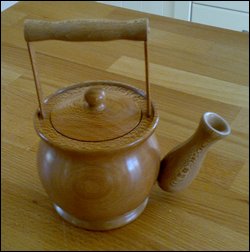 |
